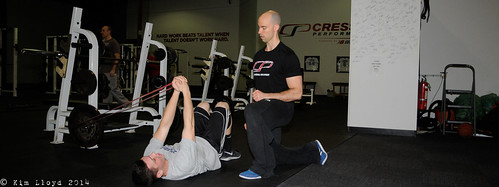5 Traits of a Successful Coach
Ask ten different people their opinion on what traits or characteristics make for a great or “successful” coach – in this case strength coach, personal trainer – and you’re bound to get ten different answers and iterations.

Copyright: neydt
5 Traits of a “Successful” Coach
Some people will use adjectives like strong, looks the part, experienced, knowledgable, professional, motivating, or “destroy the back of my pants scary.”
Others will use less germane markers such as bald, has an epic beard, or sleeps with a copy of SuperTraining underneath his or her’s pillow at night.
All are important (some more so than others) and all can be used to describe many strength coaches – or any kind of coach for that matter.
It should go without saying, but this is not an exhaustive list.
Today, though, I’d like to cover some less obvious characteristics I feel constitutes a great strength coach and/or personal trainer. Some are based off of my own personal experiences, while others fall into the camp of “it’s true because it’s my blog, and because I said so.”
1. Coaches Coach

Seems like an obvious point to start with, right? But it amazes me how many “coaches” out there don’t train anybody.
Like, ever.
Such is the paradox of this technological age we live in. The internet has made everyone into an expert or authority all because 1) they say so and/or 2) because # of followers = the pantheon of expertise.
Listen, having thousands of followers on Twitter or Instagram is impressive. Anytime you have that many people interested in what you have to say, you’re obviously doing something right.
But don’t call yourself a coach or “expert” if you’re not actually coaching people.
And this is where things get little murky and where the weeds get a little higher.
This isn’t to disrespect or devalue those who make a living online. I get it. We live in the 21st century and if nothing else, the pandemic taught us that we should be ready, willing, and able to pivot to the online space when needed.
I have many friends and colleagues who do really well for themselves coaching people in a distance based fashion:
- They’re able to help more people this way.
- They get people results.
- I can’t bemoan that.
I do it too.
However, I also still spend 15-20 hours per week in my studio coaching athletes and clients in person. That’s still very important to me. It keeps me fresh and in touch with my coaching skills. And I can guarantee many coaches online who are crushing it were FIRST doing so with in-person coaching. If you can’t coach a deadlift in person, the likelihood you’ll be able to do so over a WiFI connection with someone hundreds of miles away is pretty slim.
Moreover, if I’m going to sit here and write blog posts and articles about how to train people, I better be practicing what I preach.
But that’s just me, I can’t speak for everyone.
That’s a degree of integrity I am not willing to give up.
2. Embrace Your Coaching Style
I always gain of sense of entertainment when other coaches come to observe me coaching. I think many are surprised to recognize that I’m fairly tame in my approach.
Sure, I’ll get animated, crank up the music, and pump people up when it’s needed and warranted. But for the most part I’m about as laid back as it gets. What can I say…
…it’s my inner-introvert living it’s best life.
To be clear: No one – coaches, pirates, airplane pilots, Orcs – is 100% introverted or extroverted. We’re all a mix-n-match of the two. What I find unfortunate is that it’s the more introverted side of the spectrum that tends to get society’s consternation.
Introversion is often seen as aloofness or worse, a weakness. When all it really means is that some people are mentally drained in more social environments and need a little more kitty cuddles “me time” to re-charge.
As such, those who are more introverted are often forced to be something they’re not…much to the detriment of their comfort level, happiness, and ability to not toss their face into a brick wall.
Extroversion – while having its own set of advantages and disadvantages – is seen as a strength and preferred trait in our society.
We introverts have a ton to offer as coaches – we tend to be better listeners and are more patient as an example. I’d encourage anyone who falls into this camp to embrace their introversion, understand that compromises are going to have to be made of course (read my article linked above), and that preferring to hang out with a book on a Friday night is total boss status.
3. Pull Coaching vs. Push Coaching
It’s been pointed on many occasions in recent years – especially by the likes of Nick Winkelman and Brett Bartholomew – the power of using EXTERNAL (as opposed to using internal) cues when coaching – particularly when working with beginner or intermediate level lifters.
To Summarize:
Internal Cues = Specific bodily actions or what it’s doing in space.
External Cues = Intent, distance, or an action.
Exercise Internal Cue External Cue
1. Deadlift “Chest up.” “Show me the logo on your shirt.”
2. Squat “Knees out.” “Spread the floor.”
3. Bench Press “Arch your back.” “Meet the bar halfway.”
4. Sprinting “Extend your hip.” “Push the ground away.”
External cuing tends to have more “sticking” power and resonates more with most lifters. Nick Tumminello has a nice way of putting it:
“Speak client, not trainer”
Taking things a step further, I really love the idea of “Pull” coaching vs. “Push” coaching – a concept I stole from my good friend and colleague Tony Bonvechio.
Pull Coaching = Helping someone solve their own problems…listening to understand, asking questions, paraphrasing, suggesting options.
Push Coaching = Solving someone’s problems for them…telling, instructing, giving advice.
Both scenarios have efficacy and have their time and place. However, I’d argue we need more of the former compared to the latter. As a coach I want to EDUCATE my athletes and clients to be their own best asset; to figure shit out if I am not there. I don’t want them to have to rely on me for everything.
Like:
- When to add weight to any given exercise.
- When to temper their workouts and when to push themselves further.
- How to make simple exercise substitutions if equipment availability is an issue.
- To understand why burpees (and kipping pull-ups) are straight up dumb.
- And, do I really need to remind you to g0 Watch Beef on Netflix? FOR THE LOVE OF GOD!!!!

You know, the important stuff.
I think far too many coaches and personal trainers push at the expense of pull. Strive to empower your clients by making them more competent and encourage more autonomy (making their own choices).
4. Insatiable Desire to Get Better
Dan John sits in the front row whenever he attends a workshop or seminar. Mike Boyle still attends numerous events every year and is never afraid to backtrack or admit when he’s wrong. Ali Gilbert is the same. Eric Cressey just bragged the other day he’s listened to 25 books on Audible this year.
On 2x speed (the psychopath).
All of them have decades of coaching experience, and all are still striving to get better.
Who in the holy f**k are you?
You’ve got it all figured out huh? No need to continue to learn from others, right? It’s YOUR way or the highway? Everyone else is a moron? Got it.
A-hole.
5. Lets Stop With the “Grinding” and “Hustling”
While it’s a bit more toned down now, I’m so sick of seeing stuff like this.
We see them on social media all the time.
The “Grinders.”
The ones who are soooooo busy and soooooo swamped and have sooooooo much more of a work ethic than everyone else.
Listen, I can appreciate people with work ethic. And I’ll be the first one to champion hard work and the notion that nothing happens without some degree of sacrifice, uncomfortableness, and inconvenience. And yes, long-ass hours.
But please, spare us the inspirational quotes and grandstanding because you happened to get up before 5 AM two days in a row or, I don’t know, haven’t eaten a carb since March.
Grinding is four tours of duty in Iraq and Afghanistan. Grinding is raising a child as a single parent. Grinding is going through intensive chemotherapy and still putting a smile on your face. Grinding is listening to your co-worker brag about their CrossFit workouts and attempting to keep your eyes from rolling out of their sockets every time (s)he waxes poetic about how you’re going to die tomorrow for drinking a Diet Coke.
It has nothing to do with how superior you are because you avoid seed oils or because you train eight clients per day, six days per week.
Speaking of which:
To the “rise and grinders”…I love the work ethic, but there’s only a finite # of hours per week you’re an affective coach.
You’re not the same coach at the end of the day as you are at the start. You’re not the same coach at the start of a week as you are at the end. Touting the early wake-up times and hustle mentality isn’t the long-term flex you think it is.
It’s not a coincidence most trainers/coaches putter out after two years. They inevitably hate life.
I understand bills need to be paid, and I want to reiterate that I also understand there will be a window of time where long hours are going to happen. But be cognizant that there are only a finite number of hours where you’re an affective coach and where you’ll inevitably burn out.
There’s is a healthy balance and I hope you can find it.



Comments for This Entry
Tster
Hate to be that guy, but I've put a lot of work into my website TalkSupplement.com recently -- I promise there's some good content up there!September 15, 2015 at 1:41 pm |
Rachel
As a newer coach, I struggle with finding the appropriate amount of cueing in trying to promote client autonomy. I'm quite extroverted so I have no trouble speaking up, but I also really believe in the value of teaching others to be independent so I don't like to constantly cue. I've shadowed/worked with more experienced coaches who will cue over me if I am being quiet. In those times, I've been a little frustrated because it's not that I didn't know any cue they said but that I simply didn't want to bark commands. I guess my point is that it's been a little difficult for me to be able to assert my coaching skills/knowledge while at the same time not hand-hold. Do you have any advice for finding your style as a new coach?September 15, 2015 at 3:38 pm |
TonyGentilcore
It's important to recognize your client's learning preference as well. Some are more auditory learners. Some prefer kinesthetic. Some are visual. Some are a mix and match of a few. I find that less is more. Try this: limit yourself to only giving THREE cues when teaching a new exercise. Of course you'll have too adjust as you go, but I do feel many coaches get too fancy with how they cue exercises, which only confuses things. And, some clients will HATE to be over-cued.September 15, 2015 at 4:41 pm |
Kyle Schuant
Interesting point about the pull style of discussion, one of those things we might do without thinking about it, but if we do think about it will do better.September 15, 2015 at 7:22 pm |
TonyGentilcore
Very true. Both have merit and their advantages/disadvantages. I do feel the "pull" style is more beneficial in the long run. Sorta like teaching some how to fish.September 16, 2015 at 7:08 am |
Kyle Schuant
This ties into Rachel's comments above. With every movement, with every routine we give, there are some things we need to get right straight away, but other things which we can leave to later, some of which the person will probably figure out for themselves given time. So this is debatable: assuming the fault won't injure them, is it better to fix it NOW in one session, or wait 3 sessions for them to figure it out themselves? How about 3 weeks? 3 months? And so on. I think as with the load so with the technique, a bit better each time is good enough. Just going on with what Rachel's said, I'd be on her side. Don't chivvy the poor bugger.September 16, 2015 at 7:58 am |
TonyGentilcore
Which goes back to what I said as #1. Coaches, coach. We need to COACH our clients, be more hands-on, proactive, etc. But at the same time, sometimes, we just need to chill out with all the cueing and prodding and allow them to figure things out for themselves. Too, this is why we have regressions and progressions. If someone can't back squat due to shoulder mobility issues (as an example), adjust. Adjust the lift to the lifter so they can be successful, not vice versa.September 17, 2015 at 9:37 am |
Kyle Schuant
Of course. Your comment on the squat reminds me of a story I always tell lifters, since at the beginning they get a bit overexcited with it all. It goes like this. Much is made of the differences between famous coaches, I'm more interested in what they have in common. There's a vid of Dan John and Rippetoe talking, and it comes up, one advocates front squats, the other back squats. OMG why the difference?! Who's right?! Well, I think Rip is, BUT... let's look at this. One says front squat. The other says back squat. Front, back, which... wait, what do they have in common? They BOTH say: YOU GOTTA SQUAT The overlap between the great systems, that's where the good stuff is.September 18, 2015 at 9:21 am
Gary H
Number 5, huge pet peeve. You just lost a follower if I see for the millionth time another inspirational quote. Rise and grind? You mean wake up and go to work because you're a responsible adult and need to are fortunate to be a fitness professional for a living?! #endofrantSeptember 16, 2015 at 1:51 am |
James Fitzgerald
i'd add another trait that might trump more than others - RESULTS; after all, who are we to say what is or what is not "proper" coaching if the client is safe, has fun, is consistent, AND improves in more ways than just one... there are a lot of online trainers who can get results with the right audience because they in fact teach that client how to eat, survive and fend for themselves, and in that case, i think that trait is admirable - to teach others how to train themselves....with resultsSeptember 17, 2015 at 10:36 am |
TonyGentilcore
Of course James. Couldn't agree more. Which is why I made a note of saying I know plenty of people who are very successful doing online training. I do it too. Getting results is king. I figured that that was an obvious point, and I wanted to highlight some other "traits" not many other people talk about. If you took offense to me calling out online trainers, I apologize. That wasn't my intent.September 17, 2015 at 10:51 am |
James Fitzgerald
no offense taken at all (although we are trying to fix that area - of balance in online and in person "work" and what the market perceives vs. what is legitimate) understood on the other traits and agreed thank you for responding onwardSeptember 17, 2015 at 11:11 am |
Gainz Of The Week (9/20) – Anyman Fitness, LLC
[…] by Mike Samuels The Unspoken Truth About Online Fitness by Tanner Baze (LOVE this one…..) 5 Traits Of A Successful Coach by Tony Gentilcore One Crazy Trick: What We Can Learn From Fad Diets, Detoxes, and MLM Insanity by […]September 19, 2015 at 2:28 pm |
Hank Cho
Amen, brother.September 20, 2015 at 3:48 am |
The Best Fitness Articles From the Last Week
[…] 5 Traits of a Successful Coach via Tony Gentilcore […]September 20, 2015 at 7:48 am |
Kick Ass Core Stability Drill + Favorite Fitness Reads - Stacey Schaedler Strength
[…] 5 Traits Of A Successful Coach– Tony Gentilcore […]September 20, 2015 at 4:02 pm |
Good Fitness Reads of the Week: 9/20/2015 | AdamPine.com
[…] 5 Traits of a Successful Coach via Tony Gentilcore […]September 20, 2015 at 5:01 pm |
TUESDAY’S GOOD READS – ISSUE #11 – SEPTEMBER 22nd, 2015 - Healthy Living, Heavy Lifting
[…] 8. 5 Traits of a Successful Coach by Tony Gentilcore […]September 21, 2015 at 11:38 am |
mark
Awesome to see the idea of pull coaching being pushed! In my mind, the best coaches are educators - teaching people how to figure things out and actually understand what they are doing. Unfortunately, being a great coach could mean being a poor salesperson because your clients aren't relying on you for every little thing. I find it more gratifying when clients/patrons don't need me to hold their hands and instead only need infrequent help - that tells me I'm doing a great job. One thing I'd add to the list is that great coaches also spend time figuring out what their clients are capable of. This means asking questions and taking the time to listen to all of their needs, whether that's taking the kids to sports practice or looking after an elderly parent. Any training program is only as good as the clients ability to complete the workouts on a consistent basis. Cheers!June 25, 2023 at 7:55 pm |
Brawn
The insatiable desire to get better is a hallmark of a successful coach. It's inspiring to see experienced coaches like Dan John, Mike Boyle, Ali Gilbert, and Eric Cressey constantly seeking opportunities to learn and grow. The concept of 'Pull Coaching' versus 'Push Coaching' resonates deeply with me. Empowering our clients to solve their own problems and make informed decisions is a true mark of an exceptional coach.June 30, 2023 at 11:23 am |
Tommy
Who knows why I am reading this article in 2023... Anyways, awesome article Mr. Gentilcore, it's like looking at a mirror and seeing yourself (the bad and great parts). I love writing (in spanish though) and you've been always an inspiration. Gracias. 🙏🏽July 19, 2023 at 4:34 am |